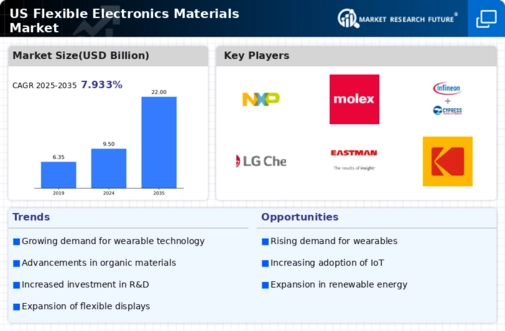Rising Demand for Wearable Technology
The flexible electronics-materials market is experiencing a surge in demand driven by the increasing popularity of wearable technology. As consumers seek devices that are not only functional but also comfortable and aesthetically pleasing, manufacturers are turning to flexible materials that can conform to the human body. This trend is reflected in the projected growth of the wearable technology sector, which is expected to reach approximately $60 billion by 2025. The integration of flexible electronics into fitness trackers, smartwatches, and health monitoring devices is likely to propel the flexible electronics-materials market forward, as these products require lightweight, durable, and flexible materials to enhance user experience.
Growing Focus on Healthcare Applications
The flexible electronics-materials market is increasingly influenced by the growing focus on healthcare applications. Flexible sensors and diagnostic devices are becoming essential in remote patient monitoring and telehealth solutions. The healthcare sector is projected to invest heavily in wearable health technology, with estimates suggesting a market size of over $30 billion by 2025. This trend indicates a rising need for flexible materials that can be integrated into medical devices, enabling continuous monitoring and data collection. As healthcare providers seek innovative solutions to improve patient outcomes, the flexible electronics-materials market is expected to thrive.
Emergence of Energy Harvesting Technologies
The flexible electronics-materials market is witnessing a notable shift towards energy harvesting technologies. These technologies enable devices to capture and utilize ambient energy, such as solar or kinetic energy, to power flexible electronics. This trend is particularly relevant in the context of the Internet of Things (IoT), where devices require sustainable power sources. The energy harvesting market is projected to grow at a CAGR of around 15% through 2025, indicating a strong potential for flexible materials that can facilitate these applications. As the demand for self-sustaining devices increases, the flexible electronics-materials market is likely to expand in response.
Advancements in Flexible Display Technologies
Innovations in flexible display technologies are significantly impacting the flexible electronics-materials market. The development of OLED and e-paper displays has opened new avenues for manufacturers, allowing for the creation of bendable and foldable screens. This advancement is particularly relevant in the consumer electronics sector, where companies are increasingly investing in flexible displays for smartphones and tablets. The flexible display market is projected to grow at a CAGR of over 20% through 2025, indicating a robust demand for materials that can support these technologies. As manufacturers seek to enhance visual quality while maintaining flexibility, the flexible electronics-materials market is poised for substantial growth.
Increased Investment in Smart Packaging Solutions
The flexible electronics-materials market is benefiting from a growing interest in smart packaging solutions. Companies are increasingly adopting flexible electronics to create packaging that can monitor product conditions, such as temperature and humidity, thereby enhancing supply chain efficiency. The smart packaging market is anticipated to reach $30 billion by 2026, with a significant portion attributed to flexible electronics. This trend suggests that as businesses prioritize sustainability and consumer safety, the demand for innovative materials that can be integrated into packaging will likely rise, further driving growth in the flexible electronics-materials market.



















Leave a Comment